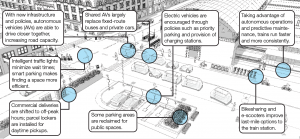Despite governments’ best efforts, traffic is getting worse in many cities, and urban mobility has become increasingly complex. Congestion carries health consequences, in the form of accidents and air pollution. Demographic trends will accentuate today’s strains, which aren’t solely about the movement of people. E-commerce is also growing fast, adding to the demand for urban commercial transport.
The technological changes create myriad opportunities for cities to address urban mobility challenges. As ridesharing grows up, digital vehicle connectivity deepens, electric vehicles (EVs) become mainstream, and autonomous vehicles (AVs) take hold, it becomes possible to envision a future of “seamless mobility.” In such an environment, the boundaries among private, shared, and public transport would be blurred, and travelers would have a variety of clean, cheap, and flexible ways to get from point A to point B.
A new McKinsey analysis presents three scenario’s for urban mobility and suggests that seamless mobility could be cleaner, more convenient, and more efficient than the status quo, accommodating up to 30 percent more traffic while cutting travel time by 10 percent.


[…] een cruciale rol zullen spelen in de stedelijke mobiliteit. Een categorie voertuigen waarvan onderzoeksbureau McKinsey onlangs nog stelde dat deze in 2030 goed kan zijn voor een wereldwijde omzet van 150 miljard […]